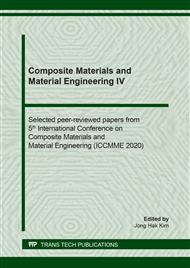[1]
E. M. Sozer, Manufacturing techniques for polymer matrix composites (PMCs), Woodhead Publishing Limited, Cambridge, (2012).
Google Scholar
[2]
WH. Seemann, Plastic transfer molding techniques for the production of fiber reinforced plastic structures, US Patent No. 4902,215, (1990).
Google Scholar
[3]
WH. Seemann, Plastic transfer molding apparatus for the production of fiber reinforced plastic structures,US Patent No. 5052,906, (1991).
Google Scholar
[4]
Marsh G. SCRIMP in context. Reinf plast41 (1997) 22–6.
Google Scholar
[5]
JB. Alms, SG. Advani, Simulation and experimental validation of flow flooding chamber method of resin delivery in liquid composite molding, Compos Part A Appl Sci Manuf38 (2007) 2131–41.
DOI: 10.1016/j.compositesa.2007.06.011
Google Scholar
[6]
JB. Alms, JL. Glancey, SG. Advani, Mechanical properties of composite structures fabricated with the vacuum induced preform relaxation process, Compos Struct92 (2010) 2811–6.
DOI: 10.1016/j.compstruct.2010.04.007
Google Scholar
[7]
JB. Alms, SG. Advani, JL. Glancey, Liquid composite molding control methodologies using vacuum induced preform relaxation, Compos Part A Appl Sci Manuf,42 (2011) 57–65.
DOI: 10.1016/j.compositesa.2010.10.002
Google Scholar
[8]
E. Ruiz, F. Trochu, Manufacture of Composites by a Flexible Injection Process Using a Double or Multiple Cavity Mold, PCT/CA2004/000959, (2004).
Google Scholar
[9]
F. Trochu, S. Soukane, B. Touraine, Flexible Injection - A Novel Liquid Molding Technology for Low Cost Composite Manufacturing. Part II - Mathematical Model, 9th International Conference on Flow Processes in Composite Materials (FPCM-9), 8-10 July 2008, Montréal (Québec), Canada.
Google Scholar
[10]
C. Niggemann, YS. Song, JW. Gillespie, Experimental investigation of the controlled atmospheric pressure resin infusion (CAPRI) process, J Compos Mater42 (2008) 1049–1061.
DOI: 10.1177/0021998308090650
Google Scholar
[11]
A. M. N. Azammi, S. M. Saquan, M. R. Ishak, M. T. H. Sultan, Conceptual design of automobile engine rubber mounting composite using TRIZ-Morphological chart-analytic network process technique, Defence Technology, vol. 14, no. 4, pp.268-277, (2018).
DOI: 10.1016/j.dt.2018.05.009
Google Scholar
[12]
C. Cempel, Application of TRIZ approach to machine vibration condition monitoring problems, Mechanical Systems and Signal Processing41 (2013) 328–334.
DOI: 10.1016/j.ymssp.2013.07.011
Google Scholar
[13]
O. Vogel, J. Ulm, Theory of proportional solenoids and magnetic force calculation using Comsol Multiphysics, Proceedings of the 2011 COMSOL Conference, Stuttgart, (2012).
Google Scholar
[14]
A. Mamoune, A. Saouab, T. Ouahbi, Simple models and optimization of compression resin transfer molding process, Journal of Reinforced Plastics & Composites30 (2011) 1629-1648.
DOI: 10.1177/0731684411421539
Google Scholar
[15]
F. Robitaille, R. Gauvin, Compaction of textile reinforcements for composites manufacturing. I: Review of experimental results, Polym Compos19 (1998) 198–216.
DOI: 10.1002/pc.10091
Google Scholar
[16]
J. Merotte, P. Simacek, SG. Advani, Resin flow analysis with fiber preform deformation in through thickness direction during compression resin transfer molding, Composites Part A41 (2010) 881–887.
DOI: 10.1016/j.compositesa.2010.03.001
Google Scholar


